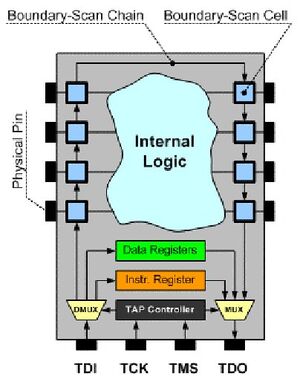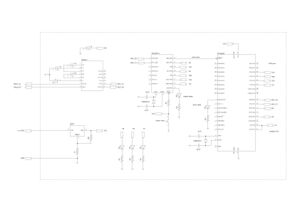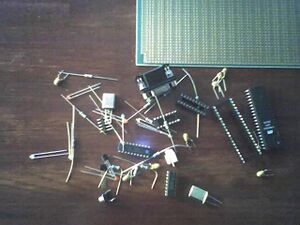Difference between revisions of "JTAG explorer toy"
| Line 2: | Line 2: | ||
[[category:projects]] | [[category:projects]] | ||
| − | [[Image:Batman.jpg|thumb|'''Fig.1: batman.''' Holy mackerel Batman! JTAG really is THE SHIT!!1]] | + | [[Image:Batman.jpg|thumb|'''Fig.1: batman.''' "Holy mackerel Batman! JTAG really is THE SHIT!!1"]] |
[[Image:michai_015_bscan.jpg|thumb|'''Fig.2: JTAG boundary-scan chain.''' A host talks to the TAP (''Test Access Port'') controller using 4 lines, shifting data in and out.]] | [[Image:michai_015_bscan.jpg|thumb|'''Fig.2: JTAG boundary-scan chain.''' A host talks to the TAP (''Test Access Port'') controller using 4 lines, shifting data in and out.]] | ||
| Line 35: | Line 35: | ||
Note that | Note that | ||
| − | this thing is '''totally useless''', so questions/comments regarding will be | + | this thing is '''totally useless''', so questions/comments regarding this issue |
| − | ignored. Xmas season, too much time, so there :-) | + | will be ignored. Xmas-season, too much time, so there :-) |
=== Overview/summary === | === Overview/summary === | ||
| Line 93: | Line 93: | ||
=== Bus-description === | === Bus-description === | ||
| − | A chip offers access to its JTAG-subsystem through a | + | A chip offers access to its JTAG-subsystem through a port ('TAP', more about this in a bit), consisting of 4 (or 5) I/O-lines: |
| − | consisting of 4 (or 5) I/O-lines: | ||
* '''TCK''' (''Test ClocK'') will be used to clock bits in/out of the device, and initiate mode-change. | * '''TCK''' (''Test ClocK'') will be used to clock bits in/out of the device, and initiate mode-change. | ||
* '''TMS''' (''Test Mode Select'') is used to traverse through the TAP-controller's state-machine. It is sampled on rising edge of <tt>TCK</tt>. | * '''TMS''' (''Test Mode Select'') is used to traverse through the TAP-controller's state-machine. It is sampled on rising edge of <tt>TCK</tt>. | ||
| Line 122: | Line 121: | ||
As mentioned before, the TAP-controller has 1 (fixed-size) instruction-register | As mentioned before, the TAP-controller has 1 (fixed-size) instruction-register | ||
and multiple, arbitrarily-sized data-registers. Although there | and multiple, arbitrarily-sized data-registers. Although there | ||
| − | are many data-registers, only one can be operated on at a time | + | are many data-registers, only one can be operated on at a time. |
One of the beautiful things, ''IMHO'', about JTAG is that the chip 'connects' one | One of the beautiful things, ''IMHO'', about JTAG is that the chip 'connects' one | ||
Revision as of 21:05, 4 January 2009
What is this, and, why..?
I heard a lot about JTAG, but never got to do anything with it, mainly because I CBA, and I didn't actually had to do anything with it.
This is of course bad, because...
JTAG is THE SHIT -- like Batman!
...or well, it's nice anyway.
Disclaimer
I interpreted the ATmega32-datasheet and (quite) some on-line docs as best as I could; however, if there's a bug/flaw somewhere, let me know please.
Note that this thing is totally useless, so questions/comments regarding this issue will be ignored. Xmas-season, too much time, so there :-)
Overview/summary
The idea for me was to make a simple toy-board with 2 MCU's on it -- one acting as JTAG host/master, and the other being JTAG-victim.
The PC talks to the master and slave through a serial protocol, to read/set pins, and so initiate JTAG-actions; master talks to slave only through its JTAG-port.
The master itself is not JTAG-enabled, but drives/reads the slave's JTAG-port I/O-pins.
What I would like to see
As I understood, JTAG offers a nice 'backdoor' into a (slave-)chip's state, and so that's what I would like to see; I'd like to...
- put it in, and take it out of reset (reset/suspend/resume)
- decouple core logic from I/O pins, and read/set them from boundary cells instead
- and some more, basically toy with it.
How JTAG works (as I understood it)
JTAG normally uses a single master/host to read/set states of one or more chips. There may be separate (JTAG) communication-channels between the host and each chip, or chips can be daisy-chained, so that the system's interface is kept simple and small.
Of course this is not complete; for more details, browse the lovely Internet.
Basic idea
Communication comes down to selecting which data to operate on, and then reading/ writing that data.
Single-chip setup
In a 1-chip JTAG-setup, the chip contains an instruction-register and a number of task-specific data-registers. The host can shift bits into each register; when a bit is shifted in, a bit falls out at the other end. Shifting always occurs in the same direction.
The host selects which data-register is active by entering an instruction-code, and then operates on the corresponding data-register. Writing/reading of both instruction- and data-registers occurs in the same way, by shifting bits in/out.
Multiple-chip setup
This works like above, except the complete system (more chips together) can be viewed as a number of big registers (where different parts/offsets in a register may live on different chips).
Bus-description
A chip offers access to its JTAG-subsystem through a port ('TAP', more about this in a bit), consisting of 4 (or 5) I/O-lines:
- TCK (Test ClocK) will be used to clock bits in/out of the device, and initiate mode-change.
- TMS (Test Mode Select) is used to traverse through the TAP-controller's state-machine. It is sampled on rising edge of TCK.
- TDI (Test Data In) is used to shift bits into the device. It is sampled on rising edge of TCK.
- TDO (Test Data out) is used to shift bits out of the device. It changes on falling edge of TCK.
See Fig.5 for an idea about timing of these signal.
Daisy-chaining chips
The TDI- and TDO-lines may be used to daisy-chain chips together -- chip #1's TDO is connected to chip #2's TDI. The host then shifts bits into chip #1's TDI, and catches bits falling out of the TDO of the last chip in the chain.
In such a daisy-chain, all chips share the TCK- and TMS-lines. Although sharing a clock may be normal, the common TMS-line was quite surprising to yours truly. But it still makes sense!
TAP-controller
The TAP (Test Access Port) controller is part of every JTAG-enabed chip, and basically implements a state machine. The TMS-line navigates between states on each rising edge of TCK.
Instructions and data
As mentioned before, the TAP-controller has 1 (fixed-size) instruction-register and multiple, arbitrarily-sized data-registers. Although there are many data-registers, only one can be operated on at a time.
One of the beautiful things, IMHO, about JTAG is that the chip 'connects' one of its data-registers between TDI and TDO on request. Subsequent operations then take place on that DR. This is no different than address-/data-selection (in that order) elsewhere, but this 'connecting' actually makes the bit-path through the chip (from TDI to TDO shorter and longer on request!
State-machine
See Fig.4: each state leads to 2 states (one of which may be itself); the selection is done by the value of TMS at the next clock pulse.
Some states 'do 1 thing, once', e.g. have the chip fill a parallel shift-register to be subsequently shifted out on TDO, but other states 'keep on doing something' during multiple TCK-cycles. To keep them in that state, TMS must be set accordingly.
A state-transition takes place after the data shifted in at that clock-pulse, if relevant, is processed. In other words, bits shifted in always apply to the current state, not the possibly new one indicated by TMS at that clock-pulse. So, if N bits must be shifted in at a state, this is how it's done:
- enter the state by setting TMS and raising TCK,
- clock the 1st (N-1) bits in, keeping TMS so that the state is not left,
- set TMS to navigate to the next state, and clock the last bit in.
Analogously, for a positive clock pulse, the bit falling out out at TDO applies to the new state, if there was a state-change at the rising edge of TCK.
Boundary-scan chain
JTAG can be used to read/stimulate I/O at a chip's pins. The chip's core logic can be decoupled from its I/O-pins as well; see Fig.3 for an idea: 'boundary-scan cells' sit in between the chip's core logic and the actual pin.
A chain of these cells ('boundary-scan chain') may be selected to sit between TDI and TDO by issueing the proper instruction, so that current/new values to/from the outside world or the chip's core logic can be shifted in or out.
Together with daisy-chaining multiple chips, this can give the developer a system where chips ('inside the socket') and e.g. PCB-tracks (between sockets) can be tested, with only 4 pins dedicated for this purpose!
JTAG-toy hardware
So ok, enough about that -- time to solder! As mentioned before, the proto-board to play with all this technology will have 2 MCU's: a JTAG-slave and a JTAG-master. The PC initiates commands to either MCU through a serial link (at a whopping 1200 bps, plenty of time to handle commands -- CBA to write proper interrupt-handlers and do proper buffering ;-)
Wiring and MCU-overkill
The slave-MCU is a big ATmega32; although we will only use about 10 I/O pins, it was the only JTAG-capable Atmel MCU I had. So there. For master I used the wonderful ATtiny2313.
As can be seen in the schematics in Fig.6, for performing actual tests using boundary-scan chain, there are dedicated I/O-lines...
- 'AB', running from master ('A') to slave ('B'),
- 'PQ', running from slave ('P') to master ('Q'),
- 'XY', running from slave ('X') to itself ('Y').
These lines have LEDs so I can see what's going on. Apart from the 4 other lines to the slave's JTAG-port, the master also controls the slave's reset-line.
From an idea by MHL, both master and slave share the Tx- and Rx-lines to a MAX232 receiver/driver. Both always receive, but only one can/should transmit at a time.
Since communication between PC and board is done in a query/response fashion, the MCU for which a query was intended, enbles its transmitter from software; its Tx-line then changes from hi-Z to active, and it sends its reply. The master and slave have a totally disjunct command-set for this to work.
work in progress, tumdedum...







